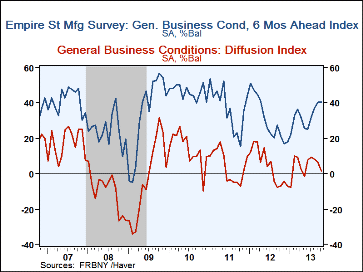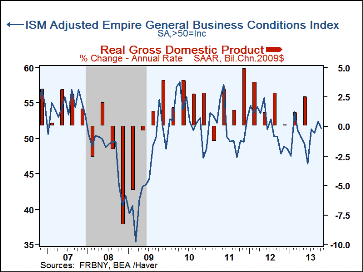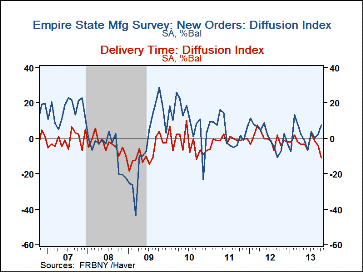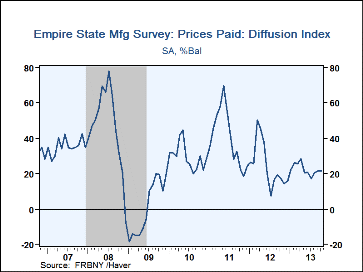 Global| Oct 15 2013
Global| Oct 15 2013Empire State Factory Index Declines
by:Tom Moeller
|in:Economy in Brief
Summary
The Federal Reserve Bank of New York reported that its Empire State Factory Index of General Business Conditions for October fell to 1.52 from an unrevised 6.29 in September. The latest figure disappointed expectations for 6.5, [...]
The Federal Reserve Bank of New York reported that its Empire State Factory Index of General Business Conditions for October fell to 1.52 from an unrevised 6.29 in September. The latest figure disappointed expectations for 6.5, according to the Action Economics Forecast Survey. Based on these figures, Haver Analytics calculates a seasonally adjusted index that is compatible to the ISM series. The adjusted figure fell to 51.4, reversing most of its September rise. An improving level of activity is indicated by a figure above 50. Since inception in 2001, the business conditions index has had a 61% correlation with the quarterly change in real GDP.
Deterioration in the overall index was paced by a sharply lower delivery times reading, indicating the quickest delivery speeds since September 2010. Most other component series fell versus September but remained up over the last twelve months. That includes the employment reading which declined to 3.61 but still indicated positive growth in hiring. During the last ten years there has been a 73% correlation between the jobs index and the m/m change in factory sector payrolls. To the upside was the new orders figure which improved to its highest level since March.
The prices paid index held roughly steady at its highest level since April. A slightly increased 25 percent of respondents reported paying higher prices while 4 percent paid less. During the last ten years, there has been a 66% correlation between the index and the 3-month change in the intermediate goods PPI.
Looking ahead, the Empire State index of expected business conditions in six months was roughly steady at 40.76, its highest level since April of last year. Improved inventories, prices paid and employment series led the gain but new orders and shipments slipped.
The Empire State figures are diffusion indexes which are calculated by subtracting the percent of respondents reporting poorer business conditions from those reporting improvement. Thus, they have a good correlation with growth in the series covered. The data is available in Haver's SURVEYS database. The ISM-adjusted headline index is calculated by Haver Analytics. The series date back only to 2001. The Consensus expectation figure is in Haver's AS1REPNA database.
Unconventional Monetary Policies and Central Bank Independence from the Federal Reserve Bank of New York can be found here.
| Empire State Manufacturing Survey | Oct | Sep | Aug | Oct'12 | 2012 | 2011 | 2010 |
|---|---|---|---|---|---|---|---|
| General Business Conditions (ISM Adjusted) | 51.4 | 52.4 | 50.8 | 47.9 | 51.8 | 51.8 | 52.9 |
| General Business Conditions (Diffusion Index, %) | 1.52 | 6.29 | 8.24 | -6.75 | 4.24 | 4.47 | 13.86 |
| New Orders | 7.75 | 2.35 | 0.27 | -7.21 | 1.38 | 4.04 | 9.96 |
| Shipments | 13.12 | 16.43 | 1.47 | -6.48 | 11.13 | 9.51 | 11.75 |
| Unfilled Orders | -6.02 | -6.45 | -6.02 | -18.28 | -8.83 | -5.29 | -6.58 |
| Delivery Time | -10.84 | -4.30 | -1.20 | -4.30 | -0.30 | -0.91 | -2.87 |
| Inventories | 0.00 | 2.15 | -3.61 | -2.15 | -2.91 | -1.80 | -1.48 |
| Number of Employees | 3.61 | 7.53 | 10.84 | -1.08 | 8.62 | 6.68 | 14.29 |
| Prices Paid | 21.69 | 21.51 | 20.48 | 17.20 | 24.71 | 40.66 | 29.63 |
Tom Moeller
AuthorMore in Author Profile »Prior to joining Haver Analytics in 2000, Mr. Moeller worked as the Economist at Chancellor Capital Management from 1985 to 1999. There, he developed comprehensive economic forecasts and interpreted economic data for equity and fixed income portfolio managers. Also at Chancellor, Mr. Moeller worked as an equity analyst and was responsible for researching and rating companies in the economically sensitive automobile and housing industries for investment in Chancellor’s equity portfolio. Prior to joining Chancellor, Mr. Moeller was an Economist at Citibank from 1979 to 1984. He also analyzed pricing behavior in the metals industry for the Council on Wage and Price Stability in Washington, D.C. In 1999, Mr. Moeller received the award for most accurate forecast from the Forecasters' Club of New York. From 1990 to 1992 he was President of the New York Association for Business Economists. Mr. Moeller earned an M.B.A. in Finance from Fordham University, where he graduated in 1987. He holds a Bachelor of Arts in Economics from George Washington University.










